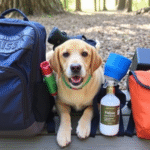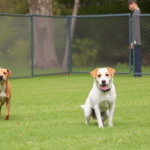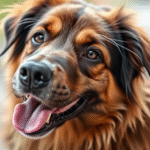The Characteristics of the Best Behaved Dog Breeds
When it comes to finding a well-mannered canine companion, certain breeds stand out due to their inherent traits and trainability. Knowing the characteristics of the best behaved dog breeds can help you choose a pet that fits seamlessly into your lifestyle. Understanding what makes certain dog breeds better behaved can lead to a happier home for both you and your furry friend.
Key Characteristics of Well-Behaved Dog Breeds
The following traits are often found in the best behaved dog breeds, making them easier to train and manage as family pets:
- Temperament: A calm and gentle demeanor is a hallmark of well-behaved dogs. Breeds that are typically friendly and sociable with people and other animals tend to be easier to train.
- Trainability: Certain breeds have a high capacity to learn commands and tricks quickly. They thrive on positive reinforcement and enjoy being rewarded for good behavior.
- Energy Level: While all dogs need exercise, breeds that are moderately active often have an easier time maintaining good behavior. Higher energy breeds may require more attention and exercise to keep them calm.
- Intelligence: Smart dogs can pick up on cues more quickly. Intelligence aids in understanding commands and following routines.
- Socialization: Breeds that have been well-socialized during their formative years tend to be more adaptable and better behaved in various situations.
Popular Well-Behaved Dog Breeds
Here are some dog breeds known for their good behavior, along with their standout characteristics:
| Breed | Key Traits |
|---|---|
| Golden Retriever | Friendly, intelligent, and adaptable. They are eager to please and respond well to training. |
| Labrador Retriever | Affectionate, highly trainable, and excellent with families. Labs enjoy learning new tricks. |
| Poodle | Extremely intelligent and hypoallergenic. They come in various sizes (standard, miniature, toy) and are known for their trainability. |
| Beagle | Curious and friendly. They have a moderate energy level and do well with training when socialized early. |
| Boxer | Playful and loyal. Boxers are known for their protective nature and require consistent training. |
The Role of Training and Socialization
Regardless of the breed, training plays a crucial role in ensuring a dog behaves well. Early and positive socialization helps dogs learn how to interact appropriately with people and other animals. Here are some training tips for creating a well-behaved dog:
- Start training young: Puppies are more adaptable and learn commands faster than older dogs.
- Use positive reinforcement: Rewarding good behavior through treats or praise encourages dogs to repeat those actions.
- Be consistent: Establishing clear rules and consistently following them helps dogs understand what is expected of them.
- Socialize regularly: Exposing dogs to various environments, people, and other pets helps mitigate anxious behavior.
Choosing the Right Breed for Your Lifestyle
It’s crucial to consider your lifestyle when selecting a dog breed. Every breed has unique needs and characteristics. A well-behaved dog is often a product of understanding and meeting those needs. For example, if you lead an active lifestyle, you might consider breeds like Labs or Boxers that enjoy exercise. Conversely, if you prefer a quieter household, breeds like Poodles or Beagles may be more suitable.
For more personalized advice or to learn more about different breeds, you can visit American Kennel Club or check out DogTime.
While several dog breeds are known for their good behavior and trainability, the key to a well-behaved dog lies in understanding the breed’s characteristics and providing consistent training and socialization. Assessing your own lifestyle and commitment will help ensure a wonderful companionship with your canine friend.
Training Techniques for a Well-Behaved Dog
Training your dog can be one of the most rewarding experiences, fostering a strong bond between you and your pet. To achieve a well-behaved dog, consider implementing a variety of techniques that are effective and enjoyable for both you and your furry friend.
Positive Reinforcement
Positive reinforcement involves rewarding your dog for displaying desirable behaviors. This technique encourages them to repeat those behaviors. Rewards can include treats, verbal praise, or playtime. Here are some effective tips for applying positive reinforcement:
- Consistently reward good behavior immediately to create a clear connection.
- Mix up the type of rewards to keep your dog motivated — use different treats, toys, or praise.
- Start with simple commands such as “sit” or “stay” before moving to more complex training.
Obedience Training Basics
Obedience training lays the groundwork for a well-behaved dog. Some fundamental commands to teach include:
- Sit: A basic command that helps your dog learn impulse control.
- Stay: Invaluable for keeping your dog in place until you release them.
- Come: An essential command that enhances your ability to call your dog back safely.
- Leave It: This command teaches your dog to disregard unwanted items or distractions.
Practice these commands in quiet environments before gradually introducing more challenging settings with distractions.
Socialization Strategies
Socializing your dog is crucial for developing a calm and well-behaved pet. Early exposure to different people, pets, and environments can prevent behavioral problems later. Here’s how to effectively socialize your dog:
- Enroll in puppy classes to meet other dogs in a controlled environment.
- Expose your dog to various situations such as busy streets, parks, and public transport.
- Encourage positive interactions with new people and animals by rewarding good behavior during these encounters.
Consistency and Routine
Dogs thrive on consistency and routine. Establish a daily schedule for feeding, walks, and playtime. Here are some ways to maintain a routine:
- Feed your dog at the same times each day.
- Take them for walks regularly, at the same times whenever possible.
- Set specific times for training sessions, as short and frequent training is often more effective than longer, infrequent sessions.
Handling Behavioral Issues
Sometimes, dogs may exhibit unwanted behaviors such as barking, chewing, or jumping. Here are strategies to address these issues:
| Behavior | Solution |
|---|---|
| Barking | Identify the cause and redirect their focus to a toy or command. |
| Chewing | Provide appropriate chew toys and supervise their access to furniture. |
| Jumping | Ignore them when they jump and reward them when they stay calm. |
By employing these strategies, you can manage behavioral issues effectively while training your dog to be well-mannered.
Professional Assistance
If you’re struggling with training, consider seeking help from a professional dog trainer or behaviorist. Organizations like the American Kennel Club provide resources to find certified trainers who can assist you in your journey. They offer workshops and informative articles that can enhance your training skills.
Creating a well-behaved dog doesn’t happen overnight; it requires patience, consistency, and love. By utilizing effective training techniques and recognizing your dog’s individual needs, you can build a lasting relationship based on trust and obedience. Remember, every dog learns at their own pace, so celebrate the small victories along the way!
For more information and resources, visit the Association of Professional Dog Trainers for expert advice and training tips tailored to your dog’s needs.
The Role of Socialization in Dog Behavior
Socialization plays a crucial role in shaping a dog’s behavior and emotional well-being. It refers to the process of exposing a dog to various environments, people, animals, and situations in a controlled manner. The benefits of socialization are immense and can significantly influence a dog’s temperament, making them more adaptable and well-adjusted.
Understanding the role of socialization can help you raise a well-behaved dog. It involves several key components that can aid in this process:
- Exposure to Various Environments: Puppies should experience different settings—parks, busy streets, and crowded places—to become accustomed to various stimuli.
- Interaction with Other Dogs: Meeting other dogs, both big and small, helps puppies learn proper dog etiquette and play behavior.
- Meeting Different People: Being around a variety of humans can ease fear and build confidence, preventing future behavioral issues.
- Handling and Grooming: Regular gentle handling helps dogs feel comfortable with touches, making vet visits and grooming sessions much easier.
The critical period for socialization occurs between 3 and 14 weeks of age, often referred to as the sensitive period. During this time, puppies are particularly receptive to new experiences. Here are several ways to ensure effective socialization:
- Start Early: Begin socialization as soon as your puppy arrives home. This is the best time to introduce new sounds, sights, and smells.
- Use Positive Reinforcement: Reward your puppy with treats or praise when they respond positively to new situations or interactions. This encourages good behavior and builds their confidence.
- Enroll in Puppy Classes: Puppy socialization classes provide a controlled environment for your puppy to meet other dogs and people, promoting playful interactions.
- Regular Outings: Make a habit of taking your dog out into different environments regularly, exposing them to new experiences throughout their life.
It’s essential to keep an eye on your dog during socialization. Signs of fear or anxiety include cowering, growling, or excessive barking. In such cases, it’s best to create a positive association with the stressful situation gradually. If necessary, consult a professional dog trainer or behaviorist to tailor a socialization plan suitable for your dog.
The relationship between socialization and behavioral problems is significant. Poorly socialized dogs can exhibit various issues such as:
- Aggression towards other dogs or people
- Separation anxiety
- Fear of loud noises or certain environments
- Excessive barking
By providing proper socialization, you can minimize these issues and help your dog develop into a well-mannered companion. Additionally, socialized dogs are less likely to fear changes in their environment, such as moving to a new house or encountering unfamiliar animals.
Understanding different breeds’ socialization needs is also vital. Some dogs, like Labrador Retrievers, are generally more adaptable. Others, like Chihuahuas, can be more cautious and require additional patience. Tailoring your approach to your dog’s breed and personality can enhance the socialization process.
Resources are available for further guidance on the topic. The American Kennel Club provides excellent information on training and socialization. Additionally, The Association of Professional Dog Trainers offers valuable tips for effective puppy socialization.
Socialization is a fundamental aspect of responsible dog ownership. Exposing your dog to varied experiences during their formative weeks profoundly impacts their growth and behavior. By investing time in socialization, you’ll not only cultivate a well-behaved dog but also enhance your bond together. Remember to be patient and consistent in the process, as every dog learns at its own pace. The reward of a well-adjusted canine companion is certainly worth the effort.
Common Behavioral Issues in Dogs and Solutions
Every dog owner wants a well-behaved companion, but common behavioral issues can make this a challenge. Understanding these problems is the first step towards resolving them. Below are some of the most frequent behavioral issues in dogs and effective solutions to curb them.
Excessive Barking
Barking can be a natural form of communication for dogs, but when it becomes excessive, it can be frustrating. Common triggers include boredom, anxiety, or alerting to perceived threats. Here are some effective solutions:
- Identify Triggers: Keep a record of when your dog barks to identify patterns.
- Provide Stimuli: Ensure your dog has plenty of toys and regular exercise to keep them engaged and satisfied.
- Training Sessions: Use commands like “quiet” or positive reinforcement when your dog stops barking.
Destructive Chewing
Chewing can lead to damaged furniture and belongings. Dogs often chew out of boredom or being anxious. Here’s how to combat destructive chewing:
- Offer Chew Toys: Provide a variety of safe chew toys to satisfy this natural urge.
- Redirect Behavior: When your dog starts chewing on furniture, redirect them to their toy.
- Supervise and Confine: Keep an eye on your dog, and limit access to tempting items until they learn appropriate chewing behavior.
Jumping on People
While many dogs are excited to greet their owners and guests, jumping can be problematic and even dangerous. Here are some ways to manage this behavior:
- Ignore the Jumping: Only provide attention or affection when your dog has all four paws on the ground.
- Training “Sit” Command: Teach your dog to sit when greeting people to prevent jumping.
- Consistent Responses: Ensure all family members follow the same approach to avoid confusing your dog.
Separation Anxiety
Dogs can struggle with separation anxiety, showing signs of distress when left alone. Recognizing and addressing this early can help. Solutions can include:
- Gradual Desensitization: Slowly get your dog used to being alone for short periods, gradually increasing the time.
- Comfort Items: Leave behind a blanket or a piece of your clothing to make them feel secure.
- Engage a Dog Walker: Hiring someone to spend time with your dog during the day can ease anxiety.
Leash Pulling
It can be exhausting when dogs pull on the leash during walks. Training them to walk calmly beside you is achievable with consistency. Here’s how:
- Use Treats: Reward your dog with treats when they walk beside you without pulling.
- Stop and Go: When they pull, stop walking until they return to your side, then proceed.
- Correct Equipment: Consider a no-pull harness for more control during walks.
Aggression
Aggression can manifest in various forms, including fear-based responses or territorial behavior. It’s essential to tackle this issue with care:
- Seek Professional Help: Hire a certified dog trainer or behaviorist to assess and work with you and your dog.
- Avoid Triggers: Identify what causes aggressive behavior and limit your dog’s exposure to those triggers.
- Calm Environment: Create a relaxed atmosphere at home to reduce stress for your dog.
Each dog is unique, and their behavioral problems can often be addressed with love, patience, and consistency. For more in-depth guidance on managing canine behavior, consider visiting resources like American Kennel Club, or PetMD for expert advice.
By implementing these strategies, you can greatly improve your dog’s behavior and strengthen your bond. With the right approach, every dog can learn to be a good dog!
How Environment Influences a Dog’s Behavior
Dogs are known for their loyalty, playfulness, and often quirky behavior. However, the environment around them plays a significant role in shaping these traits. Factors such as living conditions, social interactions, and even the climate can heavily influence a dog’s behavior. Understanding these influences can help pet owners create a more harmonious atmosphere for their furry friends.
To start, let’s look at the physical environment. A dog’s living space significantly affects its mood and behavior. Dogs need room to roam and play. Here are key elements of a dog’s physical environment to consider:
- Space: Dogs kept in small apartments may feel confined and exhibit anxiety or destructive behavior. On the other hand, dogs with access to larger spaces tend to be more relaxed.
- Stimulation: Boredom can lead to bad behavior. Interactive toys, regular walks, and playtime contribute to a dog’s mental stimulation.
- Comfort: A safe and comfortable resting place helps dogs feel secure. Quality bedding and a stress-free environment lead to happier pets.
Sensory stimulation also plays a vital role. A dog that has sensory engagements like seeing other dogs or smelling different scents will likely be more well-adjusted. Exposure to various stimuli and experiences can produce a confident dog. Lack of sensory opportunities can lead to behavioral issues.
Social environment is another critical factor. Dogs are social animals and thrive on interaction not just with humans, but with other animals as well. Lack of social interaction can lead to loneliness and increased anxiety. Here’s how social environments can affect your dog:
- Training: Training classes offer structured social interaction that helps dogs learn appropriate behavior. This also strengthens the bond between the dog and the owner.
- Playdates: Regular playdates with other dogs enhance social skills and reduce aggressive tendencies.
- Family dynamics: A stable, loving environment creates a sense of security, leading to better behaved dogs.
The emotional environment also plays a crucial role. Stress and anxiety in the household can manifest in a dog’s behavior. High-stress households with instability might produce skittish dogs or, conversely, overly aggressive ones. It’s essential to create a calm atmosphere. Here are ways to foster a better emotional environment:
- Routine: Dogs thrive on routine. Consistent feeding and walking schedules help reduce anxiety and improve behavior.
- Positive Reinforcement: Effective training methods that utilize positive reinforcement improve a dog’s behavior. Encouragement and praise foster a sense of accomplishment and security.
- Quality Time: Spending quality time with your dog can enhance their feeling of being loved and stable.
The climate also influences a dog’s behavior. Hot, humid weather can lead to irritability, while cold weather may cause dogs to want to stay indoors more. It’s essential to provide appropriate activities and conditions for your dog, regardless of the season. Here are some tips:
- Heat: On hot days, ensure your dog has access to cool areas and plenty of water. Avoid long walks during peak heat.
- Cold: Make sure your dog is adequately sheltered from the cold. Shorter walks and indoor activities may be necessary.
When trying to understand how the environment influences your dog’s behavior, it’s vital to consider the overall lifestyle. Is the dog active? Are they given enough opportunities to socialize? Are they stressed or relaxed? Each of these factors contributes significantly to your dog’s overall happiness and behavior.
Educating yourself on how to positively influence your dog’s environment can lead to successful pet ownership. Resources such as the [American Kennel Club](https://www.akc.org) and the [ASPCA](https://www.aspca.org) provide invaluable information on dog behavior and care suited to different environments. Utilizing these resources can further enhance your pet’s well-being.
In summary, the connection between a dog’s environment and its behavior is profound. Owners must recognize the impact of the space, social interactions, emotional stability, and the climate. By making adjustments in these areas, you can foster a more positive living environment that encourages good behavior in your furry companion.
Comparing the Temperament of Various Dog Breeds
When looking for the perfect canine companion, understanding the temperament of different dog breeds is crucial. Each breed has unique traits that make them better suited for different households and lifestyles. Let’s explore how various breeds compare in terms of temperament, shedding light on their personalities and behavior.
The Gentle Giants
Large dog breeds, often referred to as gentle giants, can exhibit surprisingly calm and friendly temperaments. Breeds like the Great Dane and Newfoundland are known for their affectionate nature toward families and children. Here are some key traits that characterize these loving giants:
- Affectionate: They thrive on human interaction and love to be a part of family activities.
- Laid-back: Often calm and composed, they require less exercise than one might expect considering their size.
- Gentle: These breeds are usually patient and good-natured, making them suitable for families.
The Playful Sprites
Smaller breeds, such as the Cavalier King Charles Spaniel and Pomeranian, often showcase lively and playful temperaments. Their small size means they can adapt easily to apartment living, and their personalities are huge! Here are some common characteristics:
- Energetic: These dogs enjoy playtime and often need plenty of stimulation.
- Social: Usually friendly with strangers and other pets, they love interacting with people.
- Curious: Their inquisitive nature drives them to explore their surroundings.
The Loyal Guardians
Dogs bred for herding and guarding, such as the German Shepherd and Bernese Mountain Dog, tend to have a protective but loyal temperament. While they can be more challenging to train due to their strong instincts, they make excellent companions. Their temperamental strengths include:
- Protective: Naturally protective of their families, they are ideal watchdogs.
- Eager to please: With consistent training, they often excel in obedience.
- Intelligent: These breeds typically exhibit high intelligence, making them responsive to commands.
The Sensitive Souls
Certain breeds, like the Labradoodle and Whippet, are known for their sensitivity and emotional intelligence. These dogs are highly attuned to their owners’ feelings and can form deep emotional bonds. Their defining characteristics often include:
- Empathetic: They can sense when you’re happy or sad, providing comfort during tough times.
- Trainable: Their sensitivity makes them responsive to positive training methods.
- Affectionate: Expect a lot of cuddles and warmth from these loving companions.
Temperament Comparison Table
| Breed | Size | Temperament Traits |
|---|---|---|
| Great Dane | Large | Affectionate, Laid-back, Gentle |
| Cavalier King Charles Spaniel | Small | Energetic, Social, Curious |
| German Shepherd | Large | Protective, Eager to please, Intelligent |
| Labradoodle | Medium | Empathetic, Trainable, Affectionate |
Understanding the temperament of different dog breeds can help you select a dog that fits your lifestyle. Each breed offers unique traits that can impact your daily life and companionship. For more insights on dog breeds and their temperaments, you can explore resources like the American Kennel Club for detailed information tailored to your needs.
The Importance of Consistency in Dog Training
Consistency is a fundamental principle in dog training, and it plays a critical role in establishing a solid behavioral foundation in your furry friend. Dogs thrive on routine and clear expectations. When you are consistent in your training methods, commands, and expectations, it helps your dog understand what is required of them. This clarity leads to better communication and a stronger bond between you and your pet.
Benefits of Consistency in Dog Training
Maintaining a consistent approach during training sessions offers several key benefits:
- Clarity of Commands: When commands are used consistently, dogs learn to associate words with actions more effectively. This minimizes confusion and helps them respond appropriately.
- Reinforced Learning: Regular and consistent training reinforces desirable behaviors. Repetition in similar contexts helps solidify their understanding.
- Behavior Management: A consistent training routine can help manage behavioral issues. By setting clear rules and consistently enforcing them, unwanted behaviors can be curbed.
- Confidence Building: Dogs that receive consistent messages about what is expected of them are generally more confident. This is especially important for puppies who are still learning about their environment and your expectations.
Establishing a Consistent Training Routine
To effectively train your dog, establishing a consistent routine is vital. Here’s a step-by-step guide to help you:
- Define Clear Commands: Choose simple, distinct commands for behaviors such as sit, stay, and come. Ensure everyone in your household uses the same commands to avoid confusion.
- Use Consistent Timing: Reinforce commands immediately when your dog responds correctly. This helps them connect the behavior with the reward.
- Incorporate Session Variety: While keeping commands consistent, introduce variety in training sessions, such as different locations or distractions to challenge your dog while reinforcing their learning.
- Practice Regularly: Schedule training sessions regularly. Short but frequent sessions are more effective than infrequent, lengthy ones.
- Reward Consistently: Use praise, treats, or toys consistently when your dog performs a desirable behavior. This creates positive associations with following your commands.
Common Pitfalls of Inconsistency
Inconsistency can lead to confusion and frustration for both you and your dog. Here are some common pitfalls:
- Different Commands for Same Behavior: Using different words or phrases for the same command can confuse your dog. Stick to one command per action.
- Inconsistent Rewards: If you sometimes reward a behavior and sometimes don’t, your dog may become uncertain about whether to repeat the action.
- Mixed Messages from Different Family Members: If everyone in the household does not follow the same rules and commands, it can lead to significant behavioral issues.
Additional Resources for Dog Training
For further insights and guidance on maintaining consistency in dog training, consider visiting the following resources:
Ultimately, consistency in dog training is about creating a stable environment that fosters learning and strengthens the relationship between you and your dog. By sticking to clear commands, rewarding desirable behavior, and establishing predictable routines, you set your dog up for success. Remember, the goal is to foster good behavior through understanding and trust, making your canine companion well-behaved and a joy to be around.
Key Takeaway:
When you’re on a quest to discover what the best behaved dog is, it’s essential to consider multiple factors that contribute to a dog’s overall behavior and temperament. First, understanding the characteristics of well-behaved dog breeds can guide your choice. Breeds like the Labrador Retriever, Golden Retriever, and Poodle are often recognized for their friendly and gentle nature, making them suitable companions and family pets. Their innate characteristics, combined with their ability to bond with humans, play a vital role in their behavior.
One of the most crucial aspects of a well-behaved dog is proper training. Effective training techniques, such as positive reinforcement, not only teach your dog essential commands but also help establish a strong, trusting relationship between you and your furry friend. Consistency in training sessions is key to reinforcing good behavior, as it sets clear expectations for your dog. Remember, a well-trained dog is often a well-behaved dog.
Socialization is another critical component in shaping a dog’s behavior. Introducing your dog to various environments, people, and other animals while they are still young can significantly reduce the likelihood of common behavioral issues such as fear and aggression. A well-socialized dog is typically more adaptable and comfortable in new situations, contributing to their overall good behavior.
However, even the best-trained and socialized dogs can exhibit behavioral issues. Being aware of common problems, such as barking, chewing, or jumping, allows you to take proactive measures and implement effective solutions to address these challenges.
The environment in which a dog lives plays a significant role in its behavior. Factors like space, daily routine, and the presence of family members can influence how a dog reacts to various stimuli. Providing a stable, loving home can enhance a dog’s temperament.
In essence, achieving a well-behaved dog requires understanding characteristics of different breeds, employing effective training techniques, ensuring proper socialization, tackling behavioral issues head-on, and creating a supportive environment. By focusing on these elements, you can foster a harmonious relationship with your perfect companion.
Conclusion
Finding the best behaved dog involves understanding various elements that contribute to a dog’s temperament and behavior. Each breed comes with unique characteristics that can influence their manners and interactions with people and other pets. Breeds known for their calm demeanor and intelligence, such as the Labrador Retriever or Golden Retriever, often excel when it comes to being well-behaved companions.
Training techniques play a pivotal role in shaping a dog’s behavior. Positive reinforcement, consistency, and patience are your best tools in guiding your furry friend toward appropriate behaviors. Alongside training, socialization is key. Early and positive experiences with different environments, people, and animals can drastically improve a dog’s confidence and adaptability, leading to better behavior as they mature.
Addressing common behavioral issues is also vital for maintaining harmony in your home. Understanding these problems and implementing effective solutions can turn a challenging situation into a rewarding learning experience. Furthermore, never underestimate the impact of your environment on your dog’s behavior; a calm and structured setting can do wonders for a pet’s demeanor.
Ultimately, comparing the temperament of various breeds can help you make an informed decision. However, it’s essential to remember that each dog is an individual. The importance of consistency in training cannot be stressed enough. By applying these principles and techniques, you are well on your way to nurturing a well-behaved dog that brings joy and companionship into your life. Choosing the right approach means you will enjoy a harmonious relationship with your best friend, regardless of their breed.







Leave a Reply